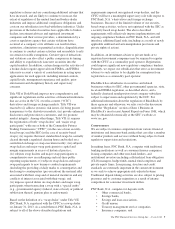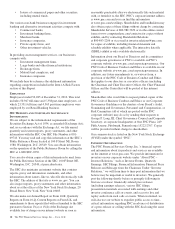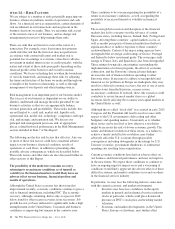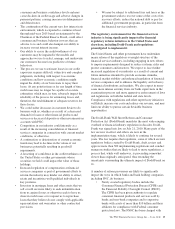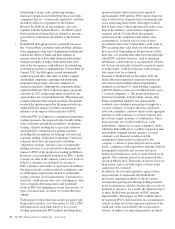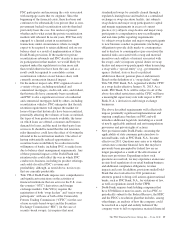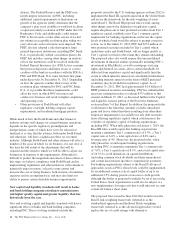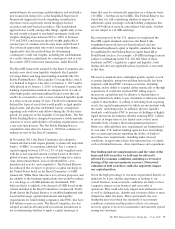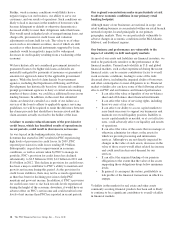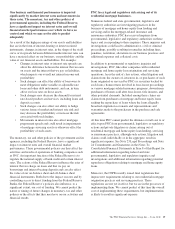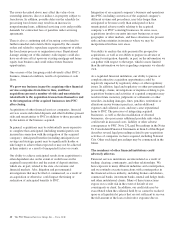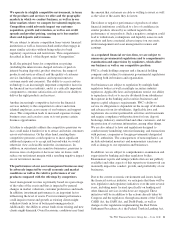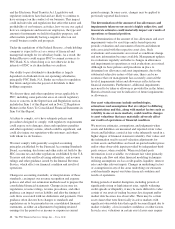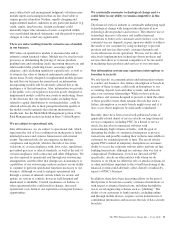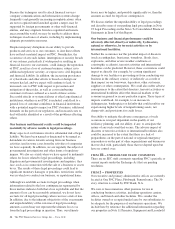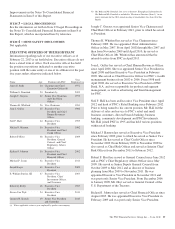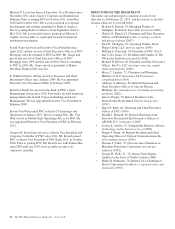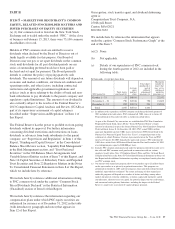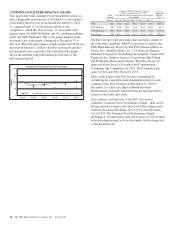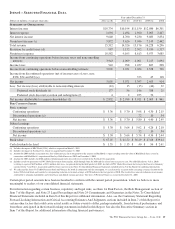PNC Bank 2012 Annual Report Download - page 38
Download and view the complete annual report
Please find page 38 of the 2012 PNC Bank annual report below. You can navigate through the pages in the report by either clicking on the pages listed below, or by using the keyword search tool below to find specific information within the annual report.Our business and financial performance is impacted
significantly by market interest rates and movements in
those rates. The monetary, tax and other policies of
governmental agencies, including the Federal Reserve,
have a significant impact on interest rates and overall
financial market performance over which we have no
control and which we may not be able to predict
adequately.
As a result of the high percentage of our assets and liabilities
that are in the form of interest-bearing or interest-related
instruments, changes in interest rates, in the shape of the yield
curve or in spreads between different market interest rates can
have a material effect on our business, our profitability and the
value of our financial assets and liabilities. For example:
• Changes in interest rates or interest rate spreads can
affect the difference between the interest that we earn
on assets and the interest that we pay on liabilities,
which impacts our overall net interest income and
profitability.
• Such changes can affect the ability of borrowers to
meet obligations under variable or adjustable rate
loans and other debt instruments, and can, in turn,
affect our loss rates on those assets.
• Such changes may decrease the demand for interest
rate-based products and services, including loans and
deposit accounts.
• Such changes can also affect our ability to hedge
various forms of market and interest rate risk and
may decrease the profitability or increase the risk
associated with such hedges.
• Movements in interest rates also affect mortgage
prepayment speeds and could result in impairments
of mortgage servicing assets or otherwise affect the
profitability of such assets.
The monetary, tax and other policies of the government and its
agencies, including the Federal Reserve, have a significant
impact on interest rates and overall financial market
performance. These governmental policies can thus affect the
activities and results of operations of banking companies such
as PNC. An important function of the Federal Reserve is to
regulate the national supply of bank credit and certain interest
rates. The actions of the Federal Reserve influence the rates of
interest that we charge on loans and that we pay on
borrowings and interest-bearing deposits and can also affect
the value of our on-balance sheet and off-balance sheet
financial instruments. Both due to the impact on rates and by
controlling access to direct funding from the Federal Reserve
Banks, the Federal Reserve’s policies also influence, to a
significant extent, our cost of funding. We cannot predict the
nature or timing of future changes in monetary, tax and other
policies or the effects that they may have on our activities and
financial results.
PNC faces legal and regulatory risk arising out of its
residential mortgage businesses.
Numerous federal and state governmental, legislative and
regulatory authorities are investigating practices in the
business of mortgage and home equity loan lending and
servicing and in the mortgage-related insurance and
reinsurance industries. PNC has received inquiries from
governmental, legislative and regulatory authorities on these
topics and is responding to these inquiries. These inquiries and
investigations could lead to administrative, civil or criminal
proceedings, possibly resulting in remedies including fines,
penalties, restitution, alterations in our business practices and
additional expenses and collateral costs.
In addition to governmental or regulatory inquiries and
investigations, PNC, like other companies with residential
mortgage and home equity loan origination and servicing
operations, faces the risk of class actions, other litigation and
claims from: the owners of, investors in, or purchasers of such
loans originated or serviced by PNC (or securities backed by
such loans), homeowners involved in foreclosure proceedings
or various mortgage-related insurance programs, downstream
purchasers of homes sold after foreclosure, title insurers, and
other potential claimants. Included among these claims are
claims from purchasers of mortgage and home equity loans
seeking the repurchase of loans where the loans allegedly
breached origination covenants and representations and
warranties made to the purchasers in the purchase and sale
agreements.
At this time PNC cannot predict the ultimate overall cost to or
effect upon PNC from governmental, legislative or regulatory
actions and private litigation or claims arising out of
residential mortgage and home equity loan lending, servicing
or reinsurance practices, although such actions, litigation and
claims could, individually or in the aggregate, result in
significant expense. See Note 23 Legal Proceedings and Note
24 Commitments and Guarantees in the Notes To
Consolidated Financial Statements in Item 8 of this Report for
additional information regarding federal and state
governmental, legislative and regulatory inquiries and
investigations and additional information regarding potential
repurchase obligations relating to mortgage and home equity
loans.
Moreover, the CFPB recently issued final regulations that
impose new requirements relating to our residential mortgage
origination practices and servicing practices. These
regulations are not yet in effect, but we are in the processes of
implementing them. We cannot predict at this time the overall
cost of implementing these requirements, but implementation
is likely to result in significant expense.
The PNC Financial Services Group, Inc. – Form 10-K 19


